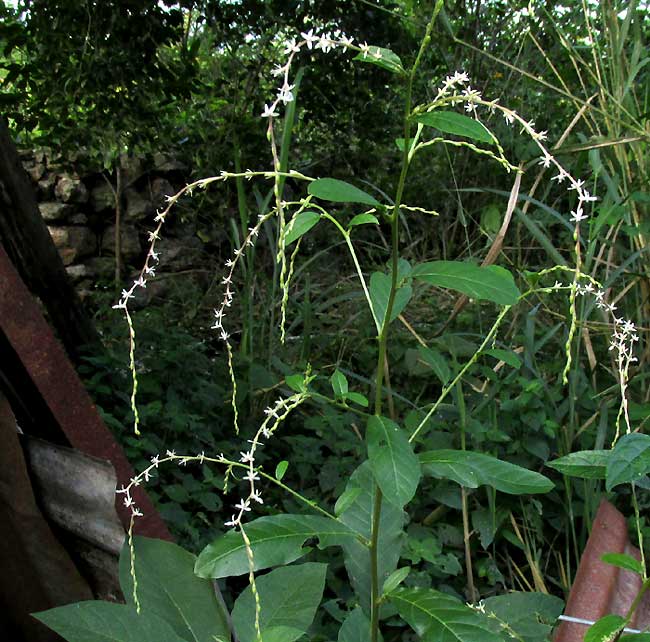Excerpts from Jim Conrad's
Naturalist Newsletter
from the February 7, 2010 Newsletter issued from Hacienda Chichen Resort beside Chichén Itzá Ruins, central Yucatán, MÉXICO; limestone bedrock, elevation ~39m (~128ft), ~N20.676°, ~W88.569°
GUINEA-HEN ROOT/ ANAMÚ
In the forest where few weeds penetrate it's getting hard to find flowering plants to profile here. However, it's easy enough to find flowering weeds. A very common one is shown below:

If you know your Eastern North America flora, can you guess what family that plant belongs to? Up North there's a familiar roadside weed much bigger than this plant, but with leaves very similar, and similarly bearing small, white flowers in slender raceme branches. How about Pokeweed? Can you see the familial similarity?
This is PETIVERIA ALLIACEA, a member of the Pokeweed Family, the Phytolaccaceae, native to nearly all the warm regions of the Americas, including southern Florida and Texas. An interesting fieldmark is how its slender racemes droop toward their tips.

Above you see one of the flowers. Typical of the Pokeweed Family, the four white, ¼-inch long (5 mm) "petals" are actually petal-like sepals, which are calyx lobes. The hairlike pink items are the stamens' filaments. One filament bears a pale anther, the baglike part producing pollen. I suspect that originally the eight stamens all bore anthers, for I've seen that the anthers drop off very easily. Maybe that's an adaptation to help avoid self-pollination. The hairy item in the flower's center is the ovary, which will develop into a fruit. You can see three fruits below:

That picture also shows how the fruits disseminate themselves: When you brush against a plant, the fruits attach themselves like Northern stick-tights. The three fruits in the picture are sticking to my leg. Notice their sharp, pale, backward-pointing spines that so effectively snag onto passing hairy legs.
Because the plant occurs in so many lands, and so many cultures regard it as medicinal, it enjoys more than the usual number of common names. In Belize the Creole speakers call it Guinea-Hen Root, in Perú it's Mucura and in French speaking countries Feuilles Ave and Herbe aux Poules. If you Google the technical name Petiveria alliacea you'll find many pages hawking it as a medical supplement under the name Anamú, the name used in the Dominican Republic and Puerto Rico.
With regard to the medicinal uses, the Wikipedia entry for the plant says that it's been used widely to treat "an astounding range of medical conditions both in humans and in animals," from cancer to hysteria, and rabies to serving as a bat repellent. "Las Plantas Medicinales de Mexico" is less enthusiastic about it, however, mentioning only that its leaves smell like a skunk (others say onion, but I find the odor rather faint) and that it serves as an antidote for any fishbite, for sores and wounds, and for several other ailments I've never heard of.